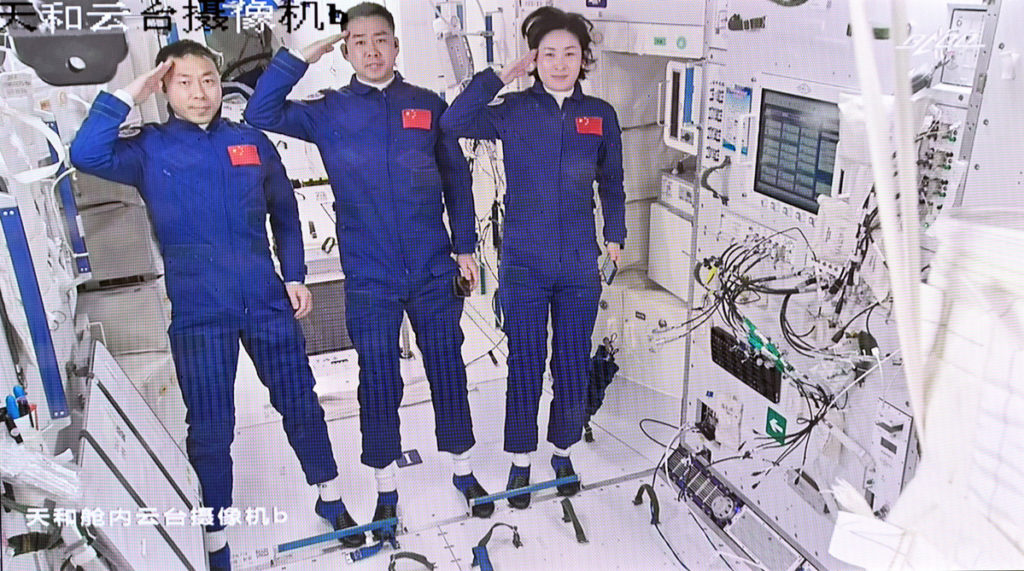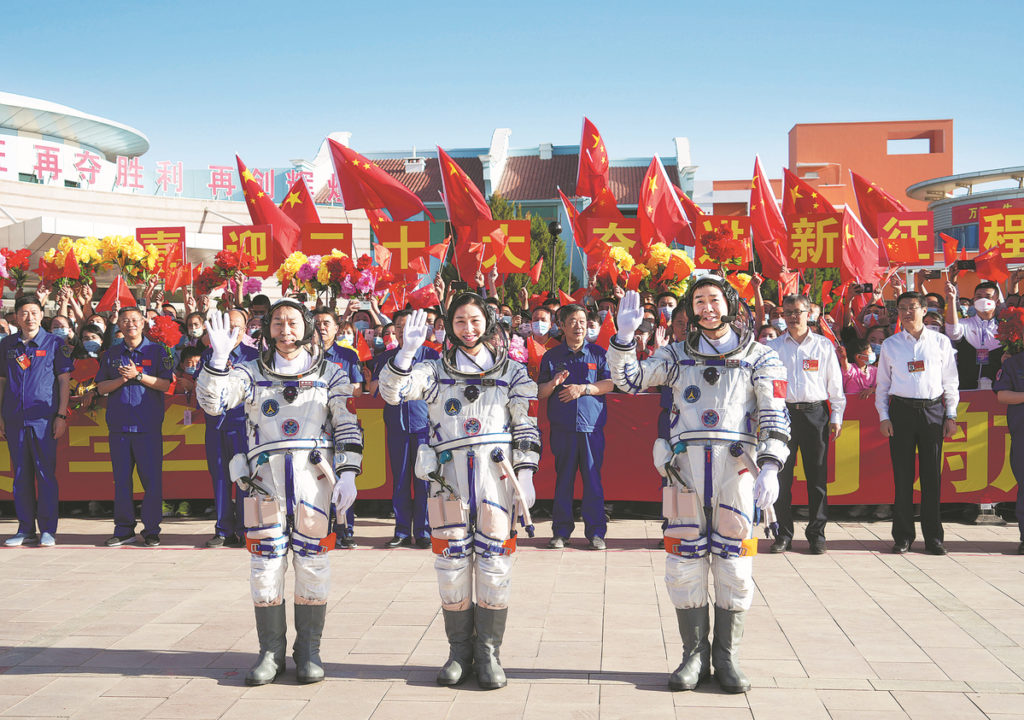The crew of the Shenzhou XIV mission, China's ninth manned spaceflight, arrived at the Tiangong space station on Sunday evening, several hours after their spacecraft was launched from the Jiuquan Satellite Launch Center in the northwestern Gobi Desert.
The three astronauts-mission commander Senior Colonel Chen Dong, Senior Colonel Liu Yang and Senior Colonel Cai Xuzhe-had entered the space station's core module, Tianhe, by 8:50 pm.
They are scheduled to stay in the outpost, orbiting 400 kilometers above the Earth, for six months to complete the assembly in space of the colossal station.
Their Shenzhou XIV spacecraft was launched by a Long March 2F rocket that blasted off at 10:44 am from a service tower at the oasislike Jiuquan center.
It is the second time that Chen and Liu have gone into space, and Cai's first, making him the 14th Chinese astronaut in outer space.
When their mission is completed, around the end of this year, the Tiangong space station will have become fully operational.
The three astronauts' mission has inaugurated a 10-year period in which, barring unforeseen circumstances, Chinese astronauts will be in space every day.
Shenzhou XIV is the sixth spacecraft to visit Tiangong and the third crewed ship to transport astronauts to the orbiting outpost.
Tiangong currently consists of four sections-Tianhe, the core module; the Shenzhou XIV craft; and the Tianzhou 3 and Tianzhou 4 cargo ships.

Shenzhou XIV crew enters Tiangong space station's core module, Tianhe. [Photo/Xinhua]
The Shenzhou XIV crew, all from the second generation of Chinese astronauts, will work with ground controllers to connect the Wentian and Mengtian space labs with the Tianhe module and then use the robotic arm to move the labs into their permanent position, said Lin Xiqiang, deputy head of China Manned Space Agency.
Wentian, the station's first lab component, will be launched in July by a Long March 5B rocket from the Wenchang Space Launch Center in Hainan province. Mengtian, the second lab component, will be launched by a Long March 5B from Wenchang in October.
After they are connected with Tiangong, the station will form a T-shaped structure.
The astronauts will also be tasked with installing and configuring equipment, conducting scientific experiments and technological demonstrations, and maintaining routine operations on Tiangong, Lin said.
They will engage in two to three spacewalks and give science lectures to students, he said.

Crew members of the Shenzhou XIV mission, Chen Dong (right), Liu Yang (center) and Cai Xuzhe, attend a preflight ceremony at the Jiuquan Satellite Launch Center, Gansu province, on June 5, 2022. Theirs is the first in a series of missions that together will see Chinese astronauts in space throughout the next 10 years. [Photo by Li Gang/Xinhua]
In the second half of the mission, the Tianzhou 5 cargo craft and Shenzhou XV crew are scheduled to arrive at the massive space station.
The Shenzhou XIV and XV crews will meet inside Tiangong and work together for a short period before Chen's crew returns to Earth in December, the official said.
Previously, the Shenzhou XII and XIII three-member crews lived inside Tiangong. The Shenzhou XIII crew returned to Earth in mid-April.
In early May, the Tianzhou 4 cargo spacecraft was launched by a Long March 7 rocket from the Wenchang Space Launch Center, transporting nearly 6 metric tons of propellants and materials to the Tiangong station.
Pang Zhihao, a retired analyst from the China Academy of Space Technology and an independent spaceflight researcher, said on Sunday that the Shenzhou XIV crew's tasks are more demanding and challenging than those handled by the Shenzhou XII and XIII crews.
"They will not only need to monitor the docking of the Tianhe module and the two space labs, but also are responsible for assembling and configuring many instruments inside the labs," he said.
"What's more, it will be the first time that large components, namely the two space labs, will be linked with the core module. There will likely be technical uncertainties that the astronauts may have to deal with."
At the end of their journey, the crew will share their experience of operating and maintaining the station with the Shenzhou XV crew, he said.
Wang Ya'nan, editor-in-chief of Aerospace Knowledge magazine, said building and running a space station is a major symbol of a great space power.
This feat-along with other recent accomplishments, such as landing a rover on Mars-marks China's leading status in the international space arena, Wang added.
The Tiangong spacecraft is expected to operate for up to 15 years and scheduled to serve as a national scientific platform, space officials have said, noting that it will also be open to foreign astronauts.
ARTICLE FROM: NewsGD.com

